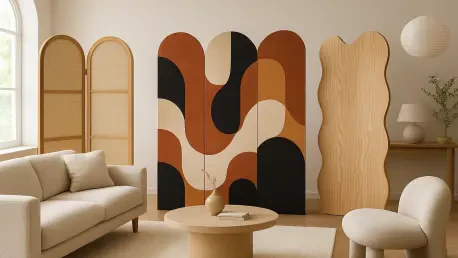Open-plan fatigue has been simmering for years as living rooms merge with kitchens and workstations spill across sightlines, and the result has been homes that feel exposed, noisy, and hard to read even when beautifully furnished. The countercurrent gathering strength now is not a full return to closed-off rooms but a smarter middle ground: “softly segmented” interiors shaped by statement dividers that organize activity, calm visual clutter, and dial in personality without heavy construction. This pivot reflects real life—people cook while kids study, friends gather while emails ping—and the need for privacy and purpose rises without the appetite for drywall dust. As the design mood tilts toward bolder gestures and nostalgia, the divider’s renaissance signals a broader shift: clarity and character are winning against sameness and echoey openness.
Why They’re Back in 2026
The allure of boundless space came with trade-offs that daily routines laid bare: constant visibility, ambient distraction, and the awkwardness of entertaining amid chores in plain view. Room dividers answer those friction points by offering just enough separation to restore focus and comfort while keeping light and circulation intact. Rather than changing floor plans, homeowners are refining them, creating reading corners that feel tucked away, work nooks that invite concentration, and dining zones that gain a sense of occasion. This is spatial editing, not erasure, and it maps to lived rhythms that need boundaries yet still delight in air and brightness.
Moreover, the cultural appetite for expressive interiors has returned, and dividers fit the brief by doing double duty: shaping flow while carrying visual intrigue. A steel-framed screen with fluted glass can mute kitchen busyness without crushing brightness; a vintage folding screen can animate a dead wall with pattern and patina; a slatted wood partition can lend depth and cadence to a long room. Importantly, these moves are reversible or adjustable, which matters in apartments and evolving households. The point is not to hide life but to frame it, turning open boxes into places with narrative—from morning coffee rituals to evening movie zones—without sealing doors.
Payoffs with Personality
When used with intention, the gains are immediate and layered. Sightlines settle, so the brain stops scanning every corner, and rooms feel calmer despite unchanged square footage. A divider can make a sofa’s back feel secure, convert a pass-through area into a defined library wall, or grant a compact dining table the intimacy it lacked. This kind of zoning doesn’t just organize space; it organizes behavior, cueing how a room should be used and helping hosts steer gatherings while preserving kitchen dignity. Flexibility adds another dividend: folding screens and drapery can open wide for parties or contract for deep-focus tasks, keeping layouts responsive to shifting days.
Equally important is the character dividend. Statement dividers deliver texture and architecture where none existed, turning bland stretches into focal points that feel curated rather than improvised. Glass partitions keep transparency—and avoid the “hiding a mess” read—while their frames add graphic structure. Open structural designs in wood or steel lend rhythm and shadows that evolve through the day. Custom builds can echo floor stains, trim profiles, or cabinet lines, knitting old and new into a cohesive story. The best examples look inevitable, as if the room had been waiting for that exact gesture to reconcile function with style and to anchor its identity.
How to Get It Right at Home
Intention is the line between sophistication and stopgap. Designers and creators, including @mrphoenixgrey on TikTok, caution against using screens solely to block views; the move reads like a bandage and can undermine credibility. Start by naming the job: a work perch that needs fewer distractions, a dining edge that deserves a threshold, a reading alcove that wants a back. Then match solution to purpose. In light-poor rooms, favor fluted or textured glass that scatters brightness without glare. Where circulation is tight, consider open slats or slim steel frames that guide movement rather than halt it. Scale matters: a too-tall wall can feel punitive; a too-small screen looks apologetic.
Material quality is equally decisive. Overly heavy, opaque pieces can make small homes feel pinched, while generic, flimsy designs date quickly and telegraph indecision. Instead, think of the divider as architectural art. Drapery can soften hard edges and add warmth, opening on command to restore openness; folding screens can act like mobile murals, shifting as gatherings evolve; openwork structures can stage plants, lamps, or books to stitch function into form; custom builds can tuck storage into bases or integrate shelving so every inch earns its keep. Done thoughtfully, these strategies elevated rooms, clarified routines, and set a clear path forward for anyone ready to trade echoey openness for purposeful, light-filled definition.









